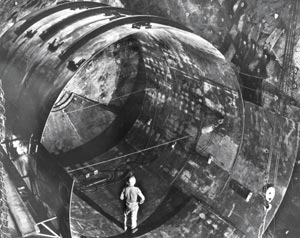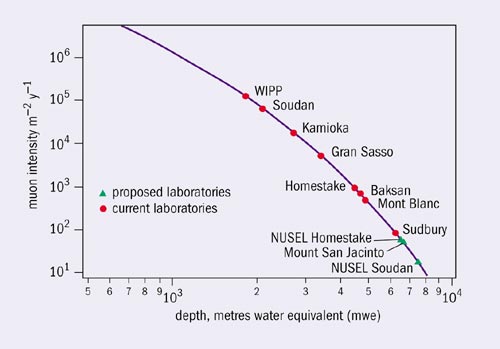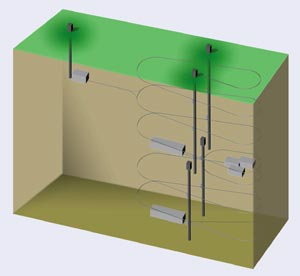The announcement that pumping will stop at the Homestake mine has clouded the future of the favoured site for a proposed major underground laboratory in the US.

On 30 May, the US National Science Foundation (NSF) issued its site panel report concerning potential sites for a deep underground science and engineering laboratory for the US. The panel concluded that by far the most favourable among the proposed sites was the Homestake mine in South Dakota. However, on 2 June, the first working day after the NSF announcement, the company that owns the mine announced that the following week it would turn off the pumps that prevent the mine from flooding. Despite intense “scientific diplomacy” – including a letter to the company from Nobel prize-winning scientists – the pumps were turned off on 10 June. Now state officials are continuing their negotiations with the mine’s owners, who estimate that complete flooding could take as long as 25-30 years. Meanwhile, the underground laboratory community in the US is pursuing several options.
The idea of a National Underground Science and Engineering Laboratory (NUSEL) in the US first gathered momentum after the Homestake Mining Corporation announced the closure of the mine in autumn 2000. The Homestake mine housed the original large solar neutrino detector built by Raymond Davis, then at Brookhaven National Laboratory. At a meeting of 200 neutrino physicists in Seattle to discuss the future US Long Range Plan for Nuclear Physics, Kenneth Lande of the University of Pennsylvania, Davis’s successor as leader of the Homestake experiment, proposed taking over the entire mine for science and engineering studies. This idea was ultimately strongly endorsed in the US Long Range Plan for Nuclear Physics and by several other US national advisory committees. Other groups also identified different possible sites for a national underground laboratory, including Mount San Jacinto in California, the Waste Isolation Pilot Plant (WIPP) in New Mexico and the Soudan Laboratory in Minnesota. However, because of its extreme depth – nearly 2500 m – and well-characterized rock integrity, most attention focused on Homestake.
The Homestake proposal was based on utilizing the attributes of the existing Homestake mine. It is the deepest existing site in the US, and provides a variety of levels and great flexibility in optimizing sites for experiments. Its massive shafts and hoists provide dual access to every level, which would allow the immediate initiation of a research programme simultaneously with the construction of a new laboratory. The site is also ideal for earth sciences as it provides 3D access to approximately 9 km3 of well-characterized and interesting rock. The current proposal includes a comprehensive earth-science research programme called EarthLab, which includes studies of microbial life, fluid flow and rock deformation. Homestake also has sufficient distance (about 2000 km) from existing accelerators in the US to allow for precision studies of neutrino properties.
The proposed new layout for Homestake foresees development along the main drift at 1480 m (4400 metres water equivalent, or mwe), with existing shafts providing direct access to the surface. This is the level recommended for construction of a “megadetector” and for other experiments wanting to simplify construction and transport, while requiring moderate overburdens. The deep level at 2250 m (6500 mwe), also accessed by existing shafts, is the choice for experiments needing greater overburdens.

Despite significant efforts, progress at Homestake has been slow. Although initial talks with the US-based Homestake Mining Company were very encouraging, negotiations stalled after the Barrick Gold Corporation, a Canadian mining firm, purchased Homestake Mining Company. Intense discussions between officials of Barrick, national and local political leaders, and the NUSEL-Homestake group of scientists led by Wick Haxton of the University of Washington, failed to produce any universally agreed solutions to the technical and political challenges of converting the mine into a science and engineering lab. Barrick rejected several proposed solutions, while continuing the process of closing the mine and removing the Davis neutrino experiment. In May 2003, the NSF convened a “site panel” of seven technical experts to evaluate different proposals for an underground laboratory, in particular in terms of geological suitability and relative costs. They received proposals for three sites – Homestake, Soudan and Mount San Jacinto.
Mount San Jacinto, a 15 minute drive from the centre of Palm Springs, California, has an altitude of 3293 m, and rises 2400 m (6700 mwe) above the surrounding desert. Located in high-tech southern California, the site enjoys close proximity to many major research and teaching universities, with their assets of researchers, students and trained support staff. The proposal for this site, led by Henry Sobel of the University of California Irvine, foresees the construction of a complex of underground chambers accessed by one or two tunnels starting near the mountain’s base. The sides of the mountain rise so steeply that an 8 km horizontal tunnel could access a laboratory almost 2 km underground. One advantage of Mount San Jacinto is that, unlike Homestake and Soudan, the site is unaffected by previous operations as a mine or laboratory. It offers the opportunity of a clean start, albeit with the concomitant costs associated with the lack of an existing underground infrastructure.
The Soudan Laboratory in northeastern Minnesota is currently the largest, deepest, most active and most experienced underground laboratory in the US. It houses the Cryogenic Dark Matter Search (CDMS 2) detector and the 5500 tonne “far detector” for the Main Injector Neutrino Oscillation Search (MINOS) experiment. MINOS will use the Neutrinos at the Main Injector (NUMI) neutrino beam from Fermilab, due to start up in 2005, which is likely to be the only long baseline beam in the US and one of only three in the world, at least for the next 10 years. NUSEL at Soudan would therefore start with existing laboratories, an existing research programme and experienced staff.

The proposed design for Soudan envisages the construction of a new 17.5 km long tunnel, with a one in seven decline from the surface to the deepest new laboratories 2500 m underground. The tunnel, which is modeled on the access to the Pyhäsalmi mine in Finland, would be in the form of a race-track spiral, about 800 by 400 m in cross-section, making seven complete turns from top to bottom. Trucks driving down the incline would deliver large instrumentation and equipment to the existing laboratories 710 m underground, and to new laboratories at 1450 and 2500 m (4350 and 7500 mwe). An elevator shaft tangential to the helix would allow easy entry for staff and small items of equipment.
The NSF panel came to the conclusion that “Homestake is by far the most favourable site for an underground laboratory”, stating that the existing deep access, infrastructure and proven ability to excavate large caverns at relatively low cost, made it “an obvious choice”. Soudan was considered a “possible back-up” site, but was not the first choice of any of the panelists, due in part to the need to develop ramps and shafts for deep access. San Jacinto was the least favourable site, and indeed considered “not a viable candidate”, due to local geology uncertainties, the potential for permission problems due to environmental issues and high relative cost.
The San Jacinto proponents disagree with the report and the process behind generating it, and have sent a letter to the NSF stating their concerns. The group feels many of the panel’s statements misrepresent the site and its benefits. There was in fact no opportunity for them to interact with the panel and correct these misconceptions.
The Homestake NUSEL collaboration intends to submit an updated project book to the NSF in the next few weeks. The collaboration was in the process of completing this more detailed proposal when the decision to flood was reached. But considering the potential delays and corresponding uncertainties associated with the flooding, the collaboration has also announced its intent to consider alternative sites, including potential new horizontal access sites in the western US.
What happens next is still unclear. The key to the future of Homestake is for political leaders to find an acceptable legal framework to facilitate the transfer of the mine by Barrick Gold. A horizontal access laboratory at Mount San Jacinto or another mountain site in the western US requires additional studies to identify and document the site. The Soudan Laboratory proponents plan to focus on the existing programme of MINOS and CDMS 2, while continuing geological and environmental studies to keep Soudan ready if Homestake falters.








